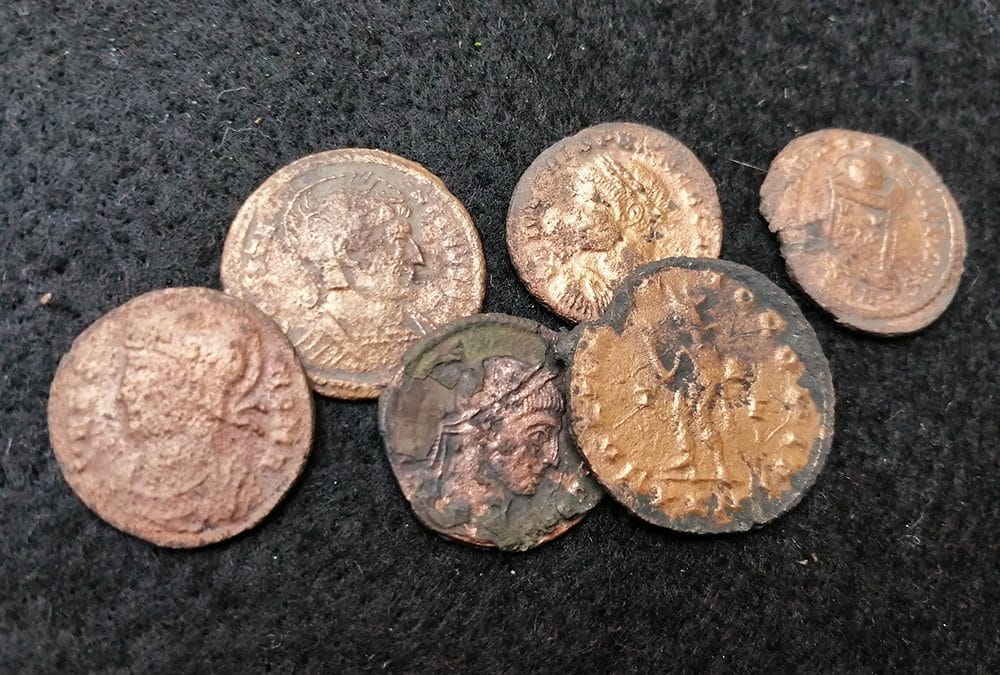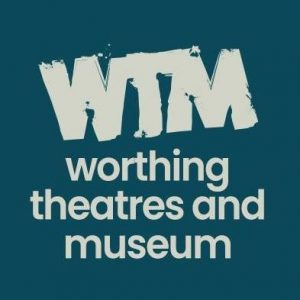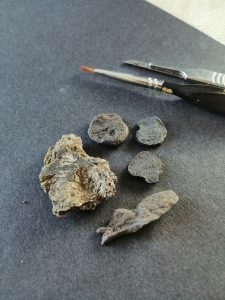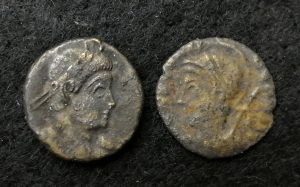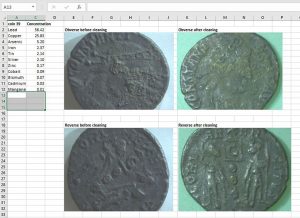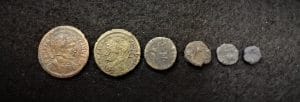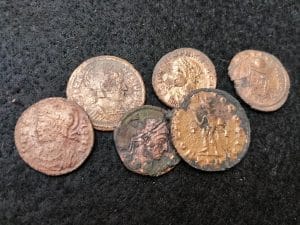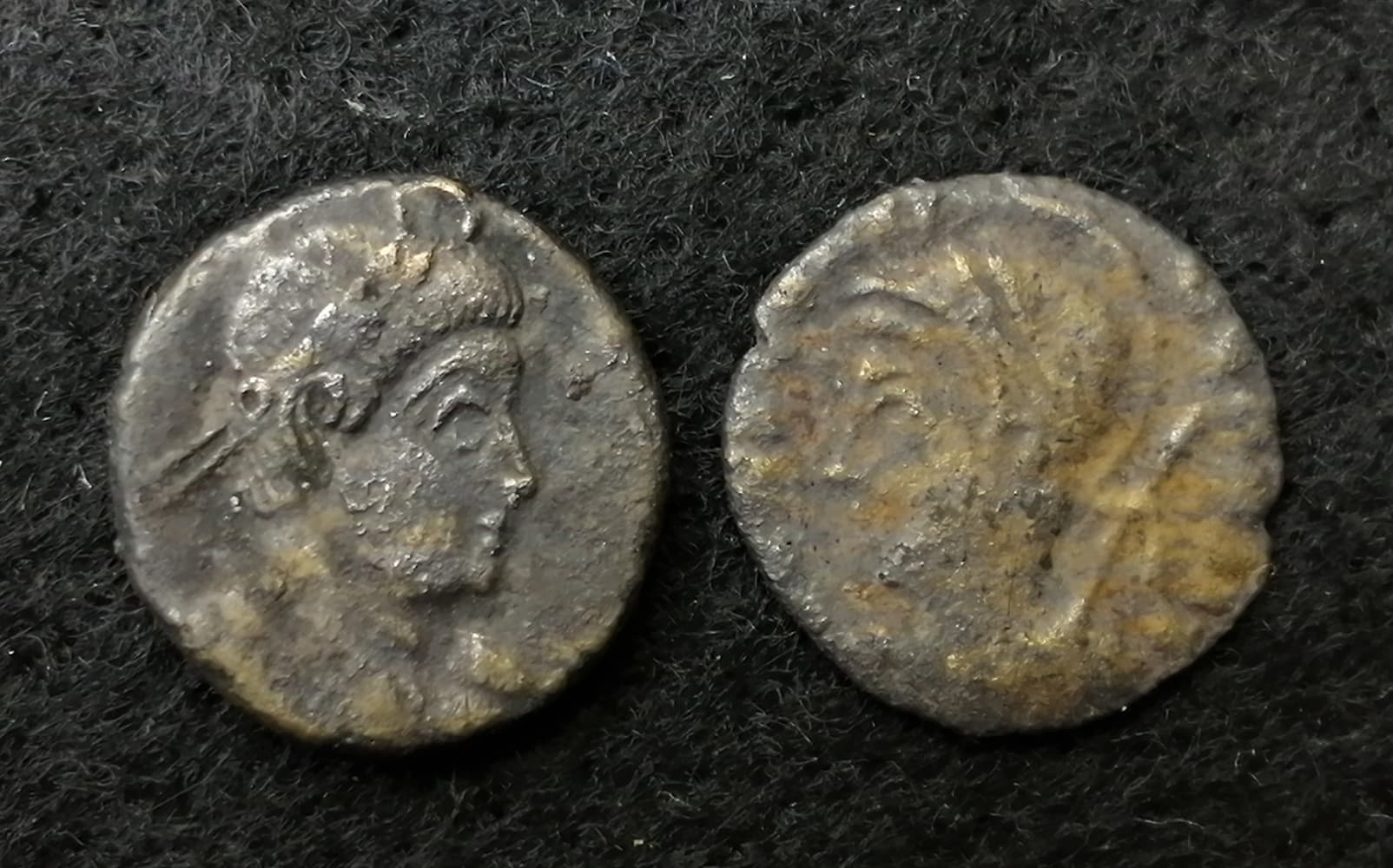
Investigative Conservation
In 2019 whilst studying metals conservation at West Dean college, Worthing’s Curator of Archaeology brought in a selection of 22 Roman coins found at an excavation on the South Downs. At this stage, not many objects had been excavated from the site, and it was thought that in ancient times inhabitants had deposited the coins at the site of a natural spring.
The site is mentioned in the Domesday Book as a Saxon settlement with watermills and light industry, however during Roman times it was already a busy and well populated area with villas, farms and villages.
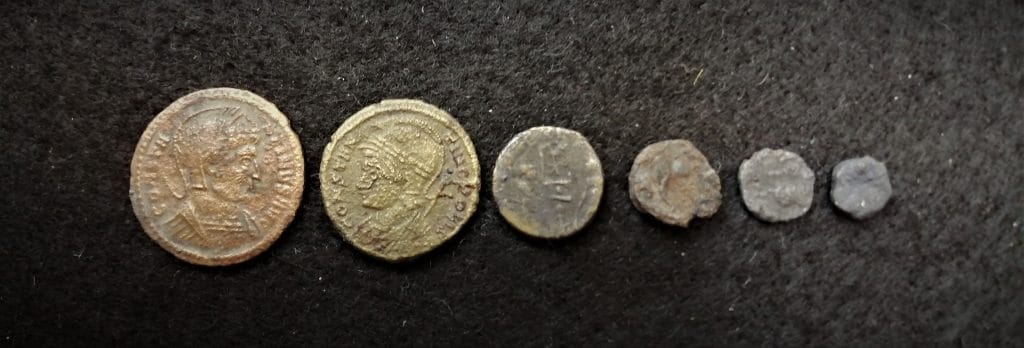
Coins
The study of currency is called Numismatics, and coins are found by detectorists and archaeologists very frequently, especially on the sites of ancient settlements. By identifying the coins, we can gain a wider understanding of timeline, who the inhabitants and local rulers were, who they traded with, local wealth, crafts and production and other relevant information. So, the chance to clean these coins for identification on a newly excavated site was very exciting.
Cleaning the Coins
The coins ranged from very good condition to very corroded, and the aim when cleaning, is to retain any detail for identification. As discussed in a previous post, the detail might be on the original surface if there is one, or within the corrosion, and in this case I began by taking an X-ray to ascertain the stability of the coins. Once this was done I could see any hairline fractures or internal voids created by corrosion so I knew where to be careful when cleaning. I began by using a brush and scalpel under a microscope and taking pictures of any detail I revealed as I went along.
In Roman coins, one would typically expect copper, silver, tin, lead, maybe iron and some other trace elements. However due to some unusual corrosion I noticed, I decided to also carry out elemental analysis to determine what they were made of. For this I used a portable XRF machine, (X-ray fluorescence) which releases a burst of X-rays onto a chosen area of the object, and gives us a reading which identifies the elements – in this case metals – of which the object is made. I used a Bruker portable XRF machine – find out more about this in the links below.
Analysis of the coins
The readings from the coins showed that there was an unusually high percentage of Lead present in many of the coins. Lead is usually found in small amounts within cast metal objects, as it makes casting easier, however 5 of the 22 coins contained more than 50% lead, some as high as 80%. The other most common elements in the readings were Copper, Tin, Iron and Silver. All the coins showed some Iron reading, some as much as 11% which would have been a deliberate inclusion in the alloy, but some as low as 0.2% which we can assume may have been an incidental ingredient or residues from the burial environment.
It is always a good idea to research the objects you are treating, so before making assumptions I researched the possibility that Romans did mint coins made from lead. This revealed that lead tokens were issued during Roman times, however not as currency, and the detail on this set showed that they intended to imitate currency.
Analysis of Metal Casting Waste
As mentioned above, the settlement is an ongoing excavation and as more objects were discovered, I had the chance to analyse them. James gave me a bag of corroded metallic pieces, none of which were magnetic or showing red/brown rust, meaning that none were iron. Some of them were clearly identifiable as metal drips which would have been lost or discarded waste created during metal casting, and showing us that metalwork was taking place in the area. Other pieces were evidently metal, but with a surrounding corrosion of grey and white flakes, which I suspected were lead or tin, or an alloy of similar white metals. We can make an educated guess at the metal, but until it is analysed we cannot say for definite what it is, and this may affect the treatment procedure.
Again, I used the XRF machine to gain a reading on 3 of the pieces which showed that one larger piece was 95% tin, and others up to 95% lead or an alloy of lead and tin. Since then, objects which look like coin blanks have also been excavated from the site. We have not had an opportunity to analyse them but it is probable that they are made of Lead. Added to the unusual base metal of the ‘coins’ previously analysed, one theory is that the inhabitants were forging Roman coins. This wasn’t unusual in ancient times, and you can find out more from the links below.
In this case, some of the least visually interesting discoveries – corroded lumps – have given us some very interesting information, allowing us to piece together the activities which took place in the settlement, and demonstrating perfectly how collaboration between conservators, archaeologists and amateur enthusiasts benefits our further understanding of the past.
Know More
XRF Machine – XRF is an acronym for x-ray fluorescence, a process whereby electrons are displaced from their atomic orbital positions, releasing a burst of energy that is characteristic of a specific element. This release of energy is then registered by the detector in then XRF instrument, which in turn categorises the energies by element.
Counterfeit Coins – Around 650 BCE, on the eastern shore of the Aegean Sea, coinage was invented. Very soon afterward, ancient counterfeiters and their counterfeit coinage appeared, and it has been with us ever since. Counterfeiting has been called the world’s “second oldest profession”.

